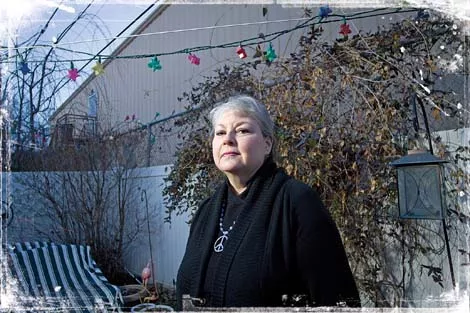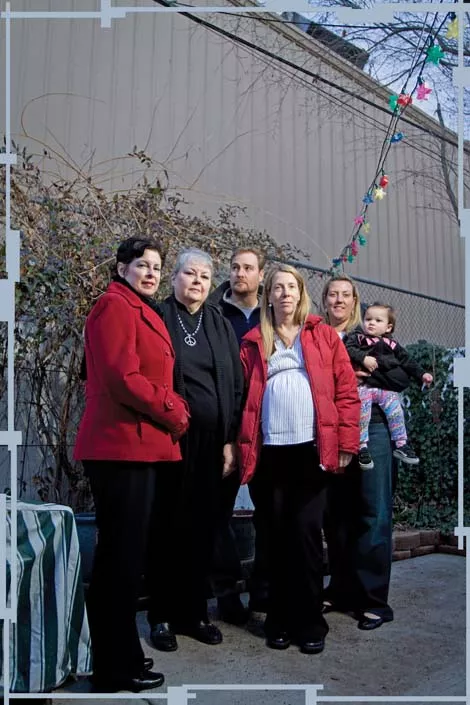The former residential-property developer knew he couldn’t go back to building homes. “Someone with a sexoffender conviction having the key to your house doesn’t work well,” he says.
So, he shifted to commercial development in the Guadalupe neighborhood in north Salt Lake City. He bought land adjacent to the railroad tracks in 2005 for $1.1 million, which was developed into offices and commercial space. Two years later, he purchased the adjoining warehouse and began renovating it into what would in 2009 become the multi-use venue The Rail Event Center (235 N. 500 West).
Before Gollaher, developers were afraid to enter an area blighted by drugs, boarded-up houses and graffiti, says Maria Garciaz, the executive director for the nonprofit NeighborWorks. Driving that point home, Gollaher recalls local Hispanic women hugging him in gratitude for investing in their neighborhood.

McCracken, whose home faces the back of The Rail, and the residents of 10 neighboring homes—among them a 28-year-old firefighter, a 65-year-old Navy veteran, and a couple with a 10-month-old baby—don’t necessarily want the multi-use venue shut down. After all, something worse could replace it. But they want their quiet back, qualified though it may be by the background hum of the neighboring freeway and railroad tracks. Those noises, however, are steadier, and the residents are accustomed to them. The noise of the 44,000-square-foot Rail, and particularly its bass vibration, is altogether different.
As McCracken e-mailed city officials in October last year, “We are literally being driven from our homes after 10 years of peace and quiet by a business that should never have been permitted to open a rock-concert venue 30 feet from our windows.”
At first sight, the strange saga of The Rail and its increasingly ill-tempered feud with its immediate neighbors comes down to what Salt Lake Valley Health compliance officer James Bennett described to a colleague in an e-mail as “poor planning” by Salt Lake City’s planning department. While The Rail is in the city’s jurisdiction—and its use is permitted because of its light-manufacturing zoning, according to Salt Lake City Mayor Ralph Becker—the county is responsible for noise issues.
In an October e-mail to county officials, Bennett wrote, “As we approach maximum build-out in Salt Lake County, these types of problems are going to continue unless the cities and the county start to look beyond the property lines at who these facilities might affect. I have seen too many cases of ‘let them build it, see what happens, and if there are problems call the Health Department.’ ” Look a little deeper, though, and a more complex picture emerges. On the fringes of the murky world of venue owners and concert promoters, two lives collided. One was convicted sex-offender Gollaher, a driving force behind The Rail. The other was paralegal and Bliss Court resident activist, McCracken, who ironically works with sex offenders and says the courts and society frequently mistreat them. Now, she’s the one who feels abused.
Gollaher says he is not hiding his past:
“I bought it, it’s part of who I am.” He tells everyone he meets about “my cancerous history.” On Jan. 19, 2010, that history caught up with him, when he was returned to prison for parole violations.
In or out of prison, McCracken doesn’t judge him, she just wants her restful nights back. No more nights of The Rail’s bass leaking into her home at 1 a.m., no more police officers standing in her home, telling her there’s nothing they can do.
Noise and Dissonance
While
its tin roof compounds The Rail’s noise issues, Gollaher’s record as a
convicted felon has provided fodder for opponents, not all of whom are
immediate neighbors. Most notably, a woman using a pseudonym has driven
investigations by city officials and state liquor agents, using
information that Rail owners suspect may have been provided by rival
club owners worried about the competition from the new venue.

“We are literally being driven from our homes after 10 years of peace and quiet by a business that should never have been permitted to open a rock-concert venue 30 feet from our windows.”
While Gollaher’s past has been used against the club by others, Gollaher’s child-abuse conviction is a red herring for the sleep-deprived Bliss Court residents. The only question that matters to McCracken and her neighbors is whether The Rail is committed to finding a solution to the noise problem that, they say, is ruin ing their lives.
“Nobody wants to take the hit for screwing up here and, as a result, nobody wants to take responsibility for fixing it,” McCracken says. “Everyone is standing on the sidelines, wringing their hands and saying our neighborhood will never be the same. How sad.”
In just eight months since opening, The Rail has certainly made a splash. Offering good deals to nonprofits, it has held bashes for The Leonardo, public radio station KRCL and the 2010 Utah Census launch, and it also showcases the popular Friday Pure gay dance night. It provides part-time work for up to 75 local employees, including some who reside on Bliss Court. With the imminent construction of the North Temple airport TRAX line, the expansion north of the Gateway retail development just a few blocks away and Becker’s $100 million-plus North Temple development plan, The Rail could have a bright future. Not, though, if competitors or detractors have their way.
All The Rail has to do, McCracken says, is turn down the volume. “They need to give me my quiet back, and no one’s willing to do that.” McCracken’s neighbor Judy Ege takes antidepressants and anxiety medi cation
for post-traumatic stress disorder stemming from her service in the U.S. Navy. She can’t take much more of The Rail. “I can’t stand it,” she says. “It pounds into my soul.” She bows her head between her hands, staring blindly at the table.
